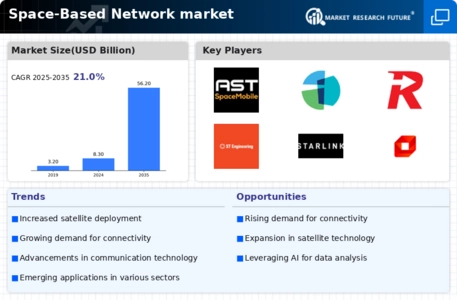Leading market players are investing heavily in research and development in order to expand their product lines, which will help the Space-Based Network Market grow even more. Market participants are also undertaking a variety of strategic activities to expand their footprint, with important market developments including new product launches, contractual agreements, mergers and acquisitions, higher investments, and collaboration with other organizations. To expand and survive in a more competitive and rising market climate, Space-Based Network industry must offer cost-effective items.
Manufacturing locally to minimize operational costs is one of the key business tactics used by manufacturers in the Space-Based Network industry to benefit clients and increase the market sector. In recent years, the Space-Based Network industry has offered some of the most significant advantages to the internet market.
Major players in the Space-Based Network Market, including Airbus SAS, Amazon, AST SpaceMobile, BridgeComm, Inc., Eutelsat Communications SA, Gilat Satellite Networks, Hughes Network Systems, Intelsat, L3Harris Tehcnologies, Inc., OneWeb, SES SA, ST Engineering iDirect, Inc., Starlink, Swarm Technologies, Inc., Telesat, Viasat, Inc., Northrop Grumman Corporation, and others, are attempting to increase market demand by investing in research and development operations.
Northrop Grumman Corporation is a multinational defense and aerospace technology organization headquartered in the United States (US). The B-21 Raider, being developed by Northrop Grumman, is a strategic bomber with stealth and extended range that can produce both conventional and nuclear missiles. Its major creativities include the creation and operation of the Lames Webb Space Telescope, an orbiting observatory scheduled for launch in 2021.
In November 2023, The Arctic Satellite Broadband Mission (ASBM), a two-satellite constellation envisioned to offer broadband communications to the Northern Polar region for the US Space Force and Space Norway, saw the successful accomplishment of Thermal Vacuum tests by Northrop Grumman Corporation.
AST SpaceMobile is a publicly listed satellite design and manufacturing company headquartered in Midland, Texas. The business is developing the SpaceMobile constellation of satellites. This space-based cellular broadband network will enable unmodified smartphones to connect to satellites in underserved areas. After being launched in 2022, the prototype BlueWalker 3 satellite will hold the title of the largest commercial communications array in low Earth orbit. In March 2023, Saudi Telcom Company ("STC") and AST SpaceMobile, Inc. inked a non-binding Memorandum of Understanding.
During the Mobile World Congress in Barcelona, the two organizations contracted a memorandum of understanding to investigate new telecom technologies and satellite-based digital services with the goal of enhancing the accessibility of mobile services.


















Leave a Comment